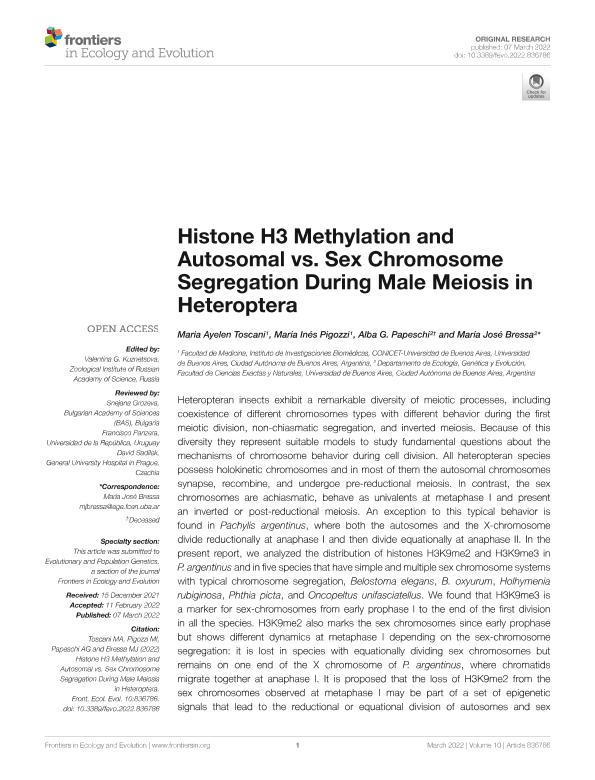Mostrar el registro sencillo del ítem
dc.contributor.author
Toscani, María Ayelén

dc.contributor.author
Pigozzi, Maria Ines

dc.contributor.author
Papeschi, Alba Graciela

dc.contributor.author
Bressa, Maria Jose

dc.date.available
2023-07-10T14:24:24Z
dc.date.issued
2022-03
dc.identifier.citation
Toscani, María Ayelén; Pigozzi, Maria Ines; Papeschi, Alba Graciela; Bressa, Maria Jose; Histone H3 Methylation and Autosomal vs. Sex Chromosome Segregation During Male Meiosis in Heteroptera; Frontiers Media; Frontiers in Ecology and Evolution; 10; 3-2022; 1-17
dc.identifier.issn
2296-701X
dc.identifier.uri
http://hdl.handle.net/11336/202950
dc.description.abstract
Heteropteran insects exhibit a remarkable diversity of meiotic processes, including coexistence of different chromosomes types with different behavior during the first meiotic division, non-chiasmatic segregation, and inverted meiosis. Because of this diversity they represent suitable models to study fundamental questions about the mechanisms of chromosome behavior during cell division. All heteropteran species possess holokinetic chromosomes and in most of them the autosomal chromosomes synapse, recombine, and undergoe pre-reductional meiosis. In contrast, the sex chromosomes are achiasmatic, behave as univalents at metaphase I and present an inverted or post-reductional meiosis. An exception to this typical behavior is found in Pachylis argentinus, where both the autosomes and the X-chromosome divide reductionally at anaphase I and then divide equationally at anaphase II. In the present report, we analyzed the distribution of histones H3K9me2 and H3K9me3 in P. argentinus and in five species that have simple and multiple sex chromosome systems with typical chromosome segregation, Belostoma elegans, B. oxyurum, Holhymenia rubiginosa, Phthia picta, and Oncopeltus unifasciatellus. We found that H3K9me3 is a marker for sex-chromosomes from early prophase I to the end of the first division in all the species. H3K9me2 also marks the sex chromosomes since early prophase but shows different dynamics at metaphase I depending on the sex-chromosome segregation: it is lost in species with equationally dividing sex chromosomes but remains on one end of the X chromosome of P. argentinus, where chromatids migrate together at anaphase I. It is proposed that the loss of H3K9me2 from the sex chromosomes observed at metaphase I may be part of a set of epigenetic signals that lead to the reductional or equational division of autosomes and sex chromosomes observed in most Heteroptera. The present observations suggest that the histone modifications analyzed here evolved in Heteroptera as markers for asynaptic and achiasmatic sex chromosomes during meiosis to allow the distinction from the chiasmatic autosomal chromosomes.
dc.format
application/pdf
dc.language.iso
eng
dc.publisher
Frontiers Media

dc.rights
info:eu-repo/semantics/openAccess
dc.rights.uri
https://creativecommons.org/licenses/by-nc-sa/2.5/ar/
dc.subject
AUTOSOMES
dc.subject
HETEROPTERA
dc.subject
HISTONE MODIFICATIONS
dc.subject
HOLOKINETIC CHROMOSOMES
dc.subject
M CHROMOSOMES
dc.subject
MEIOSIS
dc.subject
SEX CHROMOSOMES
dc.subject.classification
Otras Ciencias Biológicas

dc.subject.classification
Ciencias Biológicas

dc.subject.classification
CIENCIAS NATURALES Y EXACTAS

dc.title
Histone H3 Methylation and Autosomal vs. Sex Chromosome Segregation During Male Meiosis in Heteroptera
dc.type
info:eu-repo/semantics/article
dc.type
info:ar-repo/semantics/artículo
dc.type
info:eu-repo/semantics/publishedVersion
dc.date.updated
2023-07-07T22:19:56Z
dc.journal.volume
10
dc.journal.pagination
1-17
dc.journal.pais
Suiza

dc.journal.ciudad
Lausanne
dc.description.fil
Fil: Toscani, María Ayelén. Consejo Nacional de Investigaciones Científicas y Técnicas. Oficina de Coordinación Administrativa Houssay. Instituto de Investigaciones Biomédicas. Universidad de Buenos Aires. Facultad de Medicina. Instituto de Investigaciones Biomédicas; Argentina
dc.description.fil
Fil: Pigozzi, Maria Ines. Consejo Nacional de Investigaciones Científicas y Técnicas. Oficina de Coordinación Administrativa Houssay. Instituto de Investigaciones Biomédicas. Universidad de Buenos Aires. Facultad de Medicina. Instituto de Investigaciones Biomédicas; Argentina
dc.description.fil
Fil: Papeschi, Alba Graciela. Universidad de Buenos Aires. Facultad de Ciencias Exactas y Naturales. Departamento de Ecología, Genética y Evolución; Argentina. Consejo Nacional de Investigaciones Científicas y Técnicas; Argentina
dc.description.fil
Fil: Bressa, Maria Jose. Universidad de Buenos Aires. Facultad de Ciencias Exactas y Naturales. Departamento de Ecología, Genética y Evolución; Argentina. Consejo Nacional de Investigaciones Científicas y Técnicas; Argentina
dc.journal.title
Frontiers in Ecology and Evolution
dc.relation.alternativeid
info:eu-repo/semantics/altIdentifier/url/https://www.frontiersin.org/articles/10.3389/fevo.2022.836786/full
dc.relation.alternativeid
info:eu-repo/semantics/altIdentifier/doi/http://dx.doi.org/10.3389/fevo.2022.836786
Archivos asociados
